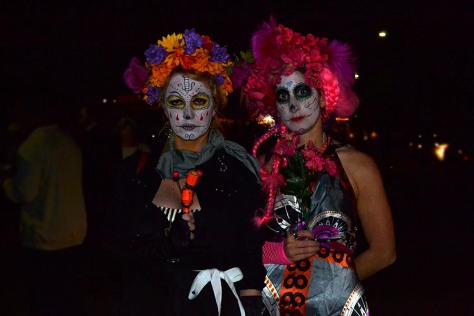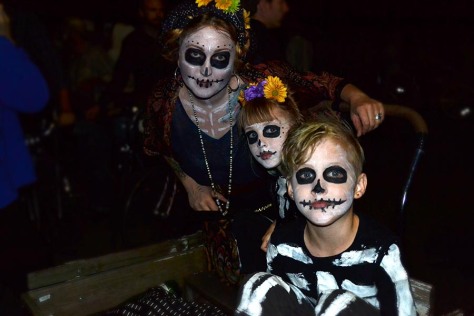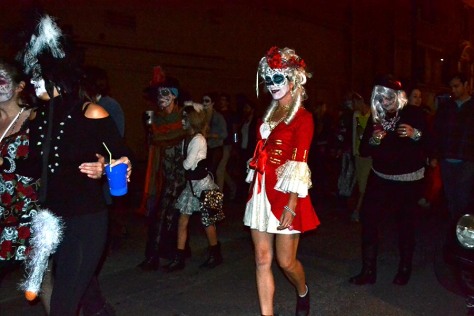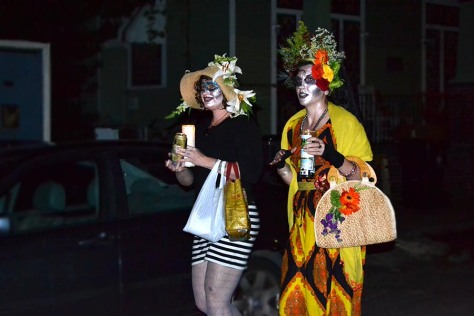I wrote this post last year for Witches and Pagans, but I thought some of you might enjoy it over here and it is appropriate for the season…
Ah yes…Thanksgiving. That time of year in America where we stuff ourselves full of turkey deliciousness and pie, then pass out in front of a football game, while probably saying “thank you Gods” for having a few paid days off of work. Of course, this isn’t what the holiday is actually about, but, as Pagans, we’ve already had our “Hooray, we got through another harvest!” feast.
When we were children, our schools filled us with images of peaceful Pilgrims and Native Americans sitting down to celebrate survival together. Hand print turkeys ran rampant over our decorations and buckled shoes seem to magically appear everywhere.
 (Oh common, you can’t tell me that you still wouldn’t do this if you got the chance).
(Oh common, you can’t tell me that you still wouldn’t do this if you got the chance).
Thanksgiving is the quintessential American holiday. And in more ways than one.
As my friend Jason Mankey will tell you, Thanksgiving itself has roots in Paganism. Of course, it’s a few months late really, but then, the Pilgrims don’t seem to have been the most competent of farmers in their new homeland. (Jason puts a nicer spin on this).
We all know the story of the Puritans coming to America and nearly starving to death in Plymouth until Squanto, the interpreter, stepped in to show the Puritans how to grow crops. In thanks, everyone sat down together to feast and make merry.
As young school children, our teachers usually didn’t cover what happened later between the Puritans and the Native Americans. It wasn’t until we were older that our young hearts got to be broken when we realized that the Puritans were not quite the kindhearted farmers that we always thought them to be, when the darker aspects of this relationship were revealed.

The Native American massacres by the Puritans have come to be fairly well known and are a hot topic of debate these days when it comes to discussing Thanksgiving. But in the midst of this well-known Thanksgiving story, massacres and all, the common record seems to gloss out another important story of early Americana Puritan history:
The history of Thomas Morton.
Who was Thomas Morton? Essentially the first British Pagan in the American colonies. Thomas Morton wanted to create a Utopian society that took the land and the “Old Ways” into consideration and integrated them with Native American practices for a new society in the New World.

(Cheerful looking fellow, Old Thomas)
Thomas Morton was a lawyer from Devon, an area of England that was already considered to have integrated Protestantism and Catholocism into the Pagan traditions of the past. Devon had just survived the Reformation and we can probably assume that there were still a lot of ill feelings in the area over the switch to Protestantism. Devon is also known as a place where “the Old Ways” of “Merry Old England” were maintained, despite the official religion of Christianity.
Morton came from an old Anglican family and was well known for championing the “displaced countrymen” of the day. He worked for the governor of Plymouth, who was majorly connected in the colonial trade. In 1618, Morton became one of the governor’s landsmen and oversaw the colonial interests. While Morton was probably not a huge fan of the Puritans before, sources note that this experience seemed to settle his dislike for his extremely religious neighbors.
Morton first went to America in 1622, but didn’t stay long due to the “intolerance” of the Puritans. When he returned in 1624, he settled a colony called Mare-Mount (for the land and sea) or, Merrymount, with a man called Wollaston. Morton fell out with Wollaston when he realized that Wollaston was selling indentured servants into what was essentially slavery to the Puritans. Wollaston was eventually driven out of Merrymount and Morton proposed a much more egalitarian society where people had equal interests in the colony. Morton called himself “The Host of Mare-Mount”.
Morton created peaceful ties with the local Algonquin tribes and started integrating Native beliefs and traditions into the colony. Morton also openly brought back many “Old English” traditions, one of which, was the Maypole.
As Morton himself said of the revels at Merrymount:
The Inhabitants of Pasonagessit (having translated the name of their habitation from that ancient Salvage name to Ma-reMount [MerryMount]; and being resolved to have the new name confirmed for a memorial to after ages) did devise amongst themselves to have it performed in a solemne manner with Revels, & merriment after the old English custorne: prepared to sett up a Maypole upon the festivall day of Philip and Jacob ; & therefore brewed a barrell of excellent beer, & provided a case of bottles to be spent, with other good cheer, for all comers of that day. And because they would have it in a complete forme, they had prepared a song fitting to the time and present occasion. And upon Mayday they brought the Maypole to the place appointed, with drums, guns, pistols, and other fitting instruments, for that purpose ; and there erected it with the help of Salvages, that came thether of purpose to see the manner of our Revels. A goodly pine tree of 80 foot long, was reared up, with a pair of buckshorns nailed one, somewhat neare unto the top of it : where it stood as a faire sea marke for directions; how to finde out the way to mine Hoste of Ma-reMount.
And because it should more fully appeare to what end it was placed there, they had a poem in readiness made, which was fixed to the Maypole, to shew the new name confirmed upon that plantation; which although it were made according to the occurrents of the time, it being Enigmatically composed) puzzled the Seperatists most pitifully to expound it. . . .
The setting up of this Maypole was a lamentable spectacle to the precise seperatists : that lived at new Plymouth. They termed it an Idoll; yea they called it the Calf of Horeb: and stood at defiance with the place, naming it Mount Dagon; threatening to make it a woefull mount and not a merry mount. . . .
There was likewise a merry song made, which (to make their Revells more fashionable) was sung with a chorus, every man bearing his part; which they performed in a dance, hand in hand about the Maypole, whiles one of the Company sung, and filled out the good liquor like gammedes and Jupiter. – Thomas Morton, Revels in New Canaan (1637)

Needless to say, this did not go over well with the Puritans.
The Puritans eventually managed to overthrown Merrymount and to capture Morton. Morton was marooned on an island and left to starve. With help from the local natives (who were apparently amused to watch this entire drama), Morton eventually managed to escape the island and make his way back to England, where, to the consternation of the Puritans, he actually managed to win a court case against the Massachusetts Bay Colony (the power behind the Puritans), which revoked their charter.
Unfortunately Merrymount did not survive under the rule of the Puritans in Morton’s absence. Also unfortunately, the politics of the day, which had supported him (King Charles was not a fan of the Puritans), failed during the English Civil War. While Morton did manage to return to America, he was captured and put on trial as a “Royalist”. While he was never actually prosecuted, he was held in prison. He did eventually make it back to Maine, where he was sheltered and finally died in 1647.
Morton said:
This harmless mirth made by young men (that lived in hope to have wives brought over to them, that would save them a labour to make a voyage to fetch any over) was much distasted, of the precise Seperatists: that keep much ado, about the tithe of Muit [mint] and Cunmin ; troubling their braines more then reason would require about things that are indifferent: and from that time sought occasion against my honest Host of Ma-reMount to overthrow his undertakings, and to destroy his plantation quite and cleane . . .
But Thomas Morton is a rather large character to sweep so easily under the rug. We get a lot of discussion and debate over the Puritans and their interactions with their Native neighbors, but who knows about Thomas Morton?
Thomas Morton would be a great example for all of those that like to tell us that our founders were all Christian, and he would be an excellent example for religious peace and tolerance.
Can you imagine what America would have been like if Thomas Morton and his Merrymount would have survived and been used as a basis for our society?
This Thursday, while you’re eating your turkey and watching your football, remember Thomas Morton and the America that might have been. If we had had more of Morton and less of the Puritans, America would probably be a very different place.


























